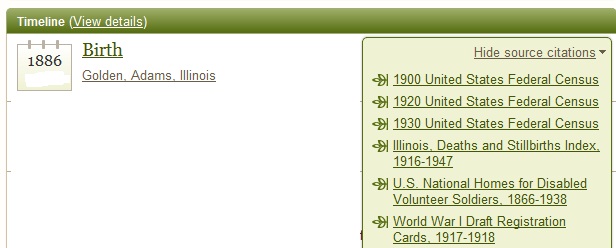This is part of one of the online trees for a relative of mine. I’ve eliminated the name and the precise date of birth because I’m more interested in how Ancestry.com handles citing sources than who this specific individual is whose birth is being cited. I’ve also seen problems like this countless times so I don’t want to appear to be picking on this entry only.

I’ve see all six “sources” used in this instance. The Ancestry.com tree indicates that all six are sources for the fact that this person was born on a certain date in a certain place. The problem is that all six sources do not say that. Tying these sources to a precise date and place of birth is indicating that they are more accurate than they really are.
- The 1900 census provides a month and year of birth along with the state.
- The 1920 and 1930 census provides an age and a place of birth. The age does not necessarily suggest a specific date–which this citation seems to indicate that it does.
- The death index does provide the date and place of birth.
- The U. S. National Home for the Disabled Volunteer Soldiers provides an approximate year of birth and a state of birth.
- The World War I draft card provides a county and state of birth along with a date of birth.
Why not just link them all to the precise date and place? After all, that’s a heck of a lot easier. It may be, but it’s a heck of a lot less accurate.
There’s only 1 of the six records that provide the specific location and date–so really only one should be listed as a source with that precise information.
Indicating a record says something it does not is confusing and in this case it looks like there are more sources with that level of detail than there are.
The date and place for an event when tied to a source for that should only be as precise as that source indicates.
Sure it takes a little more work, but it makes our work more accurate and makes analysis easier.
- Month and year in Illinois should be tied to 1900 census.
- Approximate year and location of Illinois should be tied to the 1930 census and Soldier’s Home information.
- The approximate year and county and state should be tied to the draft card.
- Specific date and specific place should be tied to the death index.

6 Responses
I’m curious how often “most” people are successful at finding the source cited by ancestry. Census, yes. The rest? I personally think I’m batting somewhere around 1%. So I use ancestry’s “proof” only because I have nothing else to use.
Shouldn’t the last two bullet points be reversed? The specific date and place of birth should be linked to the draft card, shouldn’t it?. As you stated above, the death index doesn’t give the birth information.
Yes. Thanks for catching that–I’ll fix it.
I think in writing, one would have a note that says something like Source A and C for year, Source B for month. Source C for date.
I’m not sure there’s a way around it in Ancestry.com, other than to add explanation in the description or in “Comments.”
Yes, this situation creates a lot of confusion while doing active Ancestry.com “research.”
I agree with Lisa Reed, and I want the same thing for the place field(s). Frequently the source for the “best” date has an inaccurate or too-general or no place name.
Also, in source lists for an event, Ancestry.com ranks them alphabetically, so we can’t indicate which source we consider the most important or most reliable. Other software might let us grade them as “primary,” etc., but not according to our own judgment according to “recorded soon after the event,” handwritten vs. industrially printed, “by eyewitness,” etc. Other researchers are left to crawl through a list of unranked sources and try to discern our reasons for the date and place that we post.
We could do these things on paper family group sheets. When will the software industry “get with the program”?
Actually the “best” source for a birth date is a birth certificate. Death certificates, draft cards, census, and delayed birth certificates all rely on the informant a)knowing the date and b)having no reason to lie.
The death certificate with the birthdate given by a parent (mostly for young children) is probably correct. A death certificate completed by a granddaughter-in-law, well, maybe not.
I have an ancestor who made himself older to fight in WWI and one who added a few years to his age to avoid being drafted.